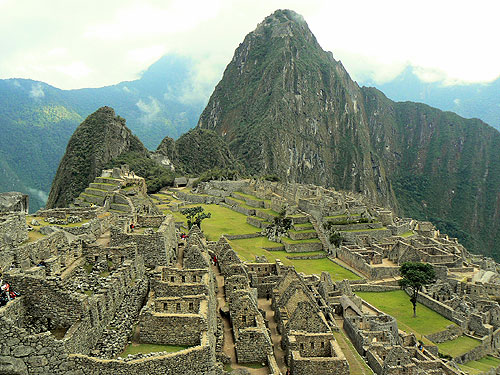Machu Picchu, Peru

Machu Picchu has been confounding the best minds for a very long time.
Nobody blames Peru for boasting of being the home to Machu Picchu; not only a top-ranking tourist attraction but also considered as one of the 7 Wonders of the World. Gorgeously located within the enchanting Andes mountain range at a height of 7,000 feet over sea level, Machu Picchu is still one of the world's least understood archaeological places. Erected at the height of the Inca's might, these ruins represent an extraordinary example of the Inca's stunning craftsmanship and stonework. Today, visitors can reach this perplexing 15th century site via train or by hiking the renowned Inca Trail. Here's my list of 5 most intriguing facts about Machu Picchu.
1. The actual name of this old city which isn't Machu Picchu, was never lost
An American adventurer by the name of Hiram Bingham, in 1911 found the Inca site which is popularly called Machu Picchu, and started a scientific investigation which would make the place world renowned. As he explored the Urubamba Valley, a native farmer sent him to Machu Picchu, also describing the location in his indigenous language. We can't truly regard Machu Picchu as the Lost City of the Incas, for there were several people residing in the area who already were aware about the site before the explorer came.
2. It's unusually well-preserved & 75% original
When the Spanish initially reached Peru in the 1500s, they destroyed several Inca holy sites, generally substituting them with their firmly believed to be superior Catholic church alternatives. Since they never discovered Machu Picchu, tourists today could visit it. The attraction's preservation could be credited to its distant location; however, there exists evidence that indicates the Incas themselves might have purposely burned walkways that led to the site.
As Hiram Bingham explored the site, he discovered Machu Picchu shrouded in forest vegetation that was soon removed to show the beautiful ruins that we know now. Although some sections of the citadel have been restored, Machu Picchu still remains significantly one of the better preserved archaeological sites during its time, retaining about 75% original. Today, tourists can just see approximately 40% of the ruins, while the other 60% remain hidden by vegetation.
To preserve the ruins as well as keep the tourist business aspect sustainable, there's in place a no-fly restriction above Machu Picchu, a one-way walking rule to decrease foot traffic, and a daily limitation of 2,500 tourists each day.
3. Machu Picchu lies deep in the jungle
Located deep in the Peruvian cloud forest, Machu Picchu is surrounded by verdant green flora. Visitors will encounter a wide range of plants, animals, insects, and more than 300 types of orchids. Generally, an abundance of llamas could be seen wandering about the site, despite these domesticated creatures are not usually found running in the wild. Fortunate visitors might even glimpse at the rare Andean bear, which is the only of its kind found in this part of the world, South America.
If you decide to go hiking the traditional route to the site through the Inca Trail, you shall be generously rewarded as you come across more of this area's unbelievable biodiversity while traveling via mountain valleys, passes, and many unique micro-climates. If not physically inclined, you can always board a train to Aguas Calientes prior to taking a bus that goes straight to Machu Picchu, helping to make the attraction accessible for tourists of all ages.
4. A lot of the construction was erected without using mortar
The Incas are famous for their advanced stonework and construction skills, and when you come by here, you'll see how truly magnificent their constructions were. One of the methods they utilized in their most holy buildings is called ashlar. Using this method, workers excessively polished and carved big granite stones, painstakingly molding them to fit perfectly together, never using clay or mortar. This stonework proved to be so uncommonly precise that not even a blade of a knife could fit in between these stones.
This kind of construction has also proven to be remarkably earthquake resistant, for it permits the stones to shift barely and then resettle with no wall collapsing. There's even evidence the Incas knew that the structure was built on many tectonic fault lines and fractures, and skillfully avoided erecting directly above these little fissures.
5. It was utilized for astronomical observation
Astonishingly, the Incas possessed much knowledge about the precise position of the moon, the sun as well as the stars. Two times each year, during each equinox, the sun would sit directly over Machu Picchu's holy Intihuantana stone, without a shadow. But at dawn on June 21, as the initial sunlight rises over the mountains, this light happens to always shine through one of the Temple of the Sun's windows, brightening a ceremonial stone.
Fired Travel Agent Tells the Public the Airline's Dirty Secrets, How to Turn Them Around In Your Favor, Including How to Fly Practically Free!

